Using a Geotrail for Teaching Geography: An Example of the Virtual Educational Trail “The Story of Liberec Granite”
Abstract
1. Introduction
2. Theoretical Background
3. Materials and Methods
- With which groups did you visit the virtual nature trail “The Story of Liberec Granite”?
- Did you use didactic materials from the nature trail website in your fieldwork? In what way?
- Have you used videos, texts and images from the nature trail website in your fieldwork? In what way?
- Did your field training include the whole route of the nature trail or only a part of it? Why did you choose this option?
- What was the response of your pupils or students to the virtual nature trail “The Story of Liberec Granite”? What did they like and what did they like less?
- What do you personally like or dislike about the virtual nature trail “The Story of Liberec Granite”? What could we improve?
- Is everything clear to you from the texts on the website, or have your pupils or students asked you a question you couldn’t answer?
- Do you think that a similar virtual nature trail could work in the countryside, or is it more suited to the city?
4. Results
4.1. The Theme of the Geotrail “The Story of Liberec Granite”
4.2. Practical Implementation of the Geotrail “The Story of Liberec Granite”
4.3. Evaluation of the Usability of the Geotrail “The Story of Liberec Granite” in Teaching
“Many students complained that the worksheets were difficult and that they were just guessing the outcome of the task. But that is the result of a bad education system, where for years they have been asked to memorize the answers or, at most, to find them in the text, not to come up with them themselves. If they are then even asked to find the answers in the field, they are completely lost.”
5. Discussion
- The geotrail should have one strong central theme that links the themes of all the stops [8,9,10,28]. This can engage students more than information about all the different things that can be seen in the area. The presence of a strong central theme was very much appreciated by the respondents and was able to engage even pupils who did not have a very positive relationship with geology.
- The stops on the geotrail should have a well-developed dramaturgy that gradually reveals new information and context [8,9,10,28]. Each stop is actually another chapter in a story that starts at the first stop and ends at the last. The content should target human emotions and use the principles of good interpretation. This is the only way for pupils to remember something.
- All texts should be written in clear language without excessive use of technical terms so that children (i.e., the target group) can understand them [1,9,10,28]. Although this was not mentioned by our interviewees, various other studies have mentioned that geological nature trails, in particular, are written in overly technical and incomprehensible language to the layperson. This is a big mistake, nature trails are not made for experts but for non-specialists.
- As younger generations are increasingly becoming less interested in reading, they need to be reached in other ways, such as through videos [1,51,52,53]. All texts should be rather shorter and interspersed with rich visual material. In addition, the short split text can also be used in fieldwork; some teachers have used it for group assignments.
- In order to draw students into the story told by the geotrail and not just be passive recipients of information, it is necessary to use engaging teaching methods [9,10,28,50]. The evaluation showed the best results for research-oriented tasks, where pupils try to figure out a fact or rule based on an experiment or observation, and for tasks requiring interaction with the environment, where pupils try to find out something directly in the field. Ideally, a set of such tasks should be available to the geotrail in the form of some didactic material. The didactic materials we developed have been evaluated very positively by teachers, although they have some shortcomings. However, teachers appreciated the fact that they did not have to create them themselves, which would have taken a lot of time.
- The use of modern technologies is possible, but not necessary. In the case of our geotrail, we used the virtual form because it was not possible to place the educational boards in the area of a listed building (moreover, the virtual trail is significantly cheaper and there is no need to deal with vandalism problems). However, the use of modern technology has certain pitfalls, hence the respondents’ reactions in this regard were varied. There are various examples of the use of modern technology in field education [52,53,54,55,56,57], with virtual and augmented reality in particular being very attractive to pupils, but the more sophisticated the technology, the more demand it places on equipment and possible internet connectivity. Some teachers thus prefer simpler options [8,49,50,51].
- The content should be appropriate for the age group [1,9,10,28,50]. The didactic materials we developed had three variants according to the age of the pupils or students. For the variant used in secondary schools, some respondents mentioned that their students found the tasks too difficult. This could have been because the tasks were aimed more at pupils of grammar schools, i.e., selective schools, and thus may have been too difficult for other students.
- If the geotrail is to be used for educational purposes, it is advisable to use professionals to graphically process all outputs and prepare the best possible support material for teachers [1,9,10,50,51]. These two things were relatively criticised with our geotrail and we would do better next time. Good graphic design increases the attractiveness of any content, and good quality methodological materials increase teachers’ willingness to use the geotrail for fieldwork. We need to figure out how to distribute the methodological materials so that students cannot download them from the internet to find out the correct answers.
6. Conclusions
Funding
Institutional Review Board Statement
Informed Consent Statement
Data Availability Statement
Conflicts of Interest
Appendix A. Translation of the Geotrail Text at Each Location into English
References
- Stolz, J.; Megerle, H.E. Geotrails as a Medium for Education and Geotourism: Recommendations for Quality Improvement Based on the Results of a Research Project in the Swabian Alb UNESCO Global Geopark. Land 2022, 11, 1422. [Google Scholar] [CrossRef]
- Prieto, J.L.P.; Martinez, G.F.D.; Gonzalez, E.M.R. Geotrails in the Mixteca Alta UNESCO Global Geopark, Oaxaca, Mexico. Cuad. Geogr. 2019, 58, 111–125. [Google Scholar] [CrossRef]
- Lewis, I.D. Linking geoheritage sites: Geotourism and a prospective Geotrail in the Flinders Ranges World Heritage Nomination area, South Australia. Aust. J. Earth Sci. 2020, 67, 1195–1210. [Google Scholar] [CrossRef]
- Kang, K.; Cho, H.; Kim, H.J.; Kim, S.; Son, M.; Kim, J.S.; Paik, I.S. The value of the Busan National Geopark’s geosites and geoheritages: A case study focused on geotrail. J. Geol. Soc. Korea 2014, 50, 21–41. [Google Scholar] [CrossRef]
- Alberico, I.; Alessio, G.; Fagnano, M.; Petrosino, P. The Effectiveness of Geotrails to Support Sustainable Development in the Campi Flegrei Active Volcanic Area. Geoheritage 2023, 15, 15. [Google Scholar] [CrossRef]
- Kubalikova, L.; Drapela, E.; Kirchner, K.; Bajer, A.; Balkova, M.; Kuda, F. Urban geotourism development and geoconservation: Is it possible to find a balance? Environ. Sci. Policy 2021, 121, 1–10. [Google Scholar] [CrossRef]
- Suto, L.; Esik, Z.; Nagy, R.; Homoki, E.; Novak, T.J.; Szepesi, J. Promoting Geoheritage Through a Field-Based Geo-education Event: A Case Study of the Hungarian Geotope Day in the Bilkk Region Geopark. Geoconservation Res. 2020, 3, 81–96. [Google Scholar] [CrossRef]
- Drapela, E. Assessing the Educational Potential of Geosites: Introducing a Method Using Inquiry-Based Learning. Resources 2022, 11, 101. [Google Scholar] [CrossRef]
- Beck, L.; Cable, T. The Gifts of Interpretation. Fifteen Guiding Principles for Interpreting Nature and Culture; Sagamore Publishing: Urbana, IL, USA, 2011; p. 205. ISBN 978-1-57167-636-8. [Google Scholar]
- Ham, S. Interpretation—Making a Difference on Purpose; Fulcrum Publishing: Golden, CO, USA, 2013; p. 320. ISBN 1555917429. [Google Scholar]
- Koike, T.; Kikuchi, T. Relationships between Landscape Evaluations of Geo-tour Participants and Interpretations of Geo-tour Guides: A Case Study of Izu-Oshima Geopark. J. Geogr. (Chigaku Zasshi) 2016, 125, 857–870. [Google Scholar] [CrossRef]
- Cheung, L.T.O. The Effect of Geopark Visitors’ Travel Motivations on their Willingness to pay for Accredited Geo-guided Tours. Geoheritage 2016, 8, 201–209. [Google Scholar] [CrossRef]
- Drapela, E. Prevention of damage to sandstone rocks in protected areas of nature in northern Bohemia. AIMS Geosci. 2021, 7, 56–73. [Google Scholar] [CrossRef]
- Sawada, I.; Takeda, K.; Kawabe, M.; Fujiyama, H. Ideas for Designing a Geotour: Suggestions from Experimental Geotour for Professional Nature Guides in Hokkaido Island, Japan. J. Geogr. (Chigaku Zasshi) 2011, 120, 853–863. [Google Scholar] [CrossRef]
- MacKay, C.; Tran, K.; Lunstrum, E. Field-Based Experiential Education in Geography: Discovering and Rethinking Urban Environmental Challenges and Possibilities. J. Geogr. 2021, 120, 61–70. [Google Scholar] [CrossRef]
- Larsen, T.; Tabor, L.; Smith, P. End of the Field? Hacking Online and Hybrid Environments for Field-Based Learning in Geography Education. J. Geogr. 2020, 120, 3–11. [Google Scholar] [CrossRef]
- Wilson, H.; Leydon, J.; Wincentak, J. Fieldwork in geography education: Defining or declining? The state of fieldwork in Canadian undergraduate geography programs. J. Geogr. High. Educ. 2017, 41, 94–105. [Google Scholar] [CrossRef]
- Medzini, A.; Meishar-tal, H.; Sneh, Y. Use of mobile technologies as support tools for geography field trips. Int. Res. Geogr. Environ. Educ. 2015, 24, 13–23. [Google Scholar] [CrossRef]
- Drapela, E.; Zagorsek, K. Příběh Liberecké Žuly (The Story of Liberec Granite). Available online: https://geostezka.fp.tul.cz/ (accessed on 20 February 2023).
- Australian Geoparks Network. What Is a Geotrail? Available online: https://australiangeoparksnetwork.org/what-is-a-geotrail/ (accessed on 20 February 2023).
- Dowling, R.K.; Newsome, D. Handbook of Geotourism; Edward Elgar Publishing: Cheltenham, UK, 2018; ISBN 1785368850. [Google Scholar]
- Reynard, E.; Brilha, J.B. (Eds.) Geoheritage: Assessment, Protection, and Management; Elsevier: Amsterdam, The Netherlands, 2018; ISBN 9780128095317. [Google Scholar]
- Drapela, E. Geotouristic potential of former quarries in Northern Bohemia. IOP Conf. Ser. Earth Environ. Sci. 2020, 609, 012079. [Google Scholar] [CrossRef]
- Newsome, D.; Dowling, R.K. Geoheritage and Geotourism. In Geoheritage: Assessment, Protection, and Management; Reynard, E., Brilha, J.B., Eds.; Elsevier: Amsterdam, The Netherlands, 2018; pp. 305–321. ISBN 9780128095317. [Google Scholar]
- Dowling, R.K.; Newsome, D. Geotourism: The Tourism of Geology and Landscape; Goodfellow Publishers: Oxford, UK, 2010; ISBN 978-1906884093. [Google Scholar]
- Brocx, M.; Semeniuk, V. Geoheritage and geoconservation—History, definition, scope and scale. J. R. Soc. West. Aust. 2007, 90, 53–87. [Google Scholar]
- Zafeiropoulos, G.; Drinia, H.; Antonarakou, A.; Zouros, N. From Geoheritage to Geoeducation, Geoethics and Geotourism: A Critical Evaluation of the Greek Region. Geosciences 2021, 11, 381. [Google Scholar] [CrossRef]
- Tilden, F. Interpreting Our Heritage; The University of North Carolina Press: Chapell Hill, North Carolina, 1957; p. 120. [Google Scholar]
- Migon, P.; Pijet-Migon, E. Exploring Causal Relationships for Geoheritage Interpretation—Variable Effects of Cenozoic Volcanism in Central European Sedimentary Tablelands. Geoheritage 2022, 14, 9. [Google Scholar] [CrossRef]
- Drapela, E.; Buechner, J. Neisseland Geopark: Concept, Purpose and Role in Promoting Sustainable Tourism. In Public Recreation and Landscape Protection—With Sense Hand in Hand; Fialová, J., Ed.; Mendel University in Brno: Brno, Czech Republic, 2019; pp. 268–272. ISBN 978-80-7509-659-3. [Google Scholar]
- France, D.; Haigh, M. Fieldwork@40: Fieldwork in geography higher education. J. Geogr. High. Educ. 2018, 42, 498–514. [Google Scholar] [CrossRef]
- Higgitt, M. Addressing the new agenda for fieldwork in higher education. J. Geogr. High. Educ. 1996, 20, 391–398. [Google Scholar] [CrossRef]
- Munge, B.; Thomas, G.; Heck, D. Outdoor Fieldwork in Higher Education: Learning from Multidisciplinary Experience. J. Exp. Educ. 2018, 41, 39–53. [Google Scholar] [CrossRef]
- Skavhaug, T.W.; Andersen, H.P. Urban fieldwork in geographical education in Levanger, Norway. Nor. J. Geogr. 2013, 67, 179–183. [Google Scholar] [CrossRef]
- Raath, S.; Golightly, A. Geography Education Students’ Experiences with a Problem-Based Learning Fieldwork Activity. J. Geogr. 2017, 116, 217–225. [Google Scholar] [CrossRef]
- Drapela, E.; Bohm, H. Interpretation of secondary geodiversity: Experience from geotouristic guide practice. In Public Recreation and Landscape Protection—With Sense Hand in Hand; Fialová, J., Ed.; Mendel University in Brno: Brno, Czech Republic, 2019; pp. 235–238. ISBN 978-807509715-6. [Google Scholar]
- Svobodova, H.; Durna, R.; Misarova, D.; Hofmann, E. A proposal of a concept of outdoor education for primary and lower secondary schools—The case of the Czech Republic. J. Adventure Educ. Outdoor Learn. 2021, 21, 336–356. [Google Scholar] [CrossRef]
- Svobodova, H.; Misarova, D.; Durna, R.; Hofmann, E. Geography Outdoor Education from the Perspective of Czech Teachers, Pupils and Parents. J. Geogr. 2020, 119, 32–41. [Google Scholar] [CrossRef]
- Nadelson, L.S.; Jordan, J.R. Student Attitudes Toward and Recall of Outside Day: An Environmental Science Field Trip. J. Educ. Res. 2012, 105, 220–231. [Google Scholar] [CrossRef]
- Drapela, E.; Zagorsek, K. Didaktické Materiály k Virtuální Naučné Stezce, Příběh Liberecké Žuly“ (Didactic Materials for the Virtual Educational Trail “The Story of Liberec Granite”). Available online: https://geostezka.fp.tul.cz/images/Didakticke-materialy.pdf (accessed on 20 February 2023).
- Andel, R.; Kvacek, R.; Lhotova, M.; Melanova, M.; Portmann, K.; Svoboda, M. Liberec; Lidove Noviny: Prague, Czech Republic, 2017; p. 517. [Google Scholar]
- Srek, J. Žulové Lomy Liberecka a Jablonecka (Granite Quarries in Liberec and Jablonec Region); Petr Polda: Liberec, Czech Republic, 2012; p. 64. [Google Scholar]
- Klominsky, J. (Ed.) Urbanistická Geologie Města Liberce (Urban geology of the City of Liberec); Czech Geological Survey: Prague, Czech Republic, 2016; p. 152. [Google Scholar]
- Zak, J.; Verner, K.; Slama, J.; Kachlik, V.; Chlupacova, M. Multistage magma emplacement and progressive strain accumulation in the shallow-level Krkonose-Jizera plutonic complex, Bohemian Massif. Tectonics 2013, 32, 1493–1512. [Google Scholar] [CrossRef]
- Adamuszek, M.; John, T.; Dabrowski, M.; Podladchikov, Y.Y.; Gertisser, R. Assimilation and diffusion during xenolith-magma interaction: A case study of the Variscan Karkonosze Granite, Bohemian Massif. Mineral. Petrol. 2009, 97, 203–222. [Google Scholar] [CrossRef]
- Zak, J.; Klominsky, J. Magmatic structures in the Krkonose-Jizera Plutonic Complex, Bohemian Massif: Evidence for localized multiphase flow and small-scale thermal-mechanical instabilities in a granitic magma chamber. J. Volcanol. Geotherm. Res. 2007, 164, 254–267. [Google Scholar] [CrossRef]
- Zak, J.; Vyhnalek, B.; Kabele, P. Is there a relationship between magmatic fabrics and brittle fractures in plutons? A view based on structural analysis, anisotropy of magnetic susceptibility and thermo-mechanical modelling of the Tanvald pluton (Bohemian Massif). Phys. Earth Planet. Inter. 2006, 157, 286–310. [Google Scholar] [CrossRef]
- Linneberg, M.S.; Korsgaard, S. Coding qualitative data: A synthesis guiding the novice. Qual. Res. J. 2019, 19, 259–270. [Google Scholar] [CrossRef]
- Padua, S.M.; Tabanez, M.; de Souza, M.D. How can nature trails be more effective? Environ. Educ. Next Gener. 1997, 263–267. [Google Scholar]
- Nevrelova, M.; Ruzickova, J. Educational Potential of Educational Trails in Terms of Their Using in the Pedagogical Process (Outdoor Learning). Eur. J. Contemp. Educ. 2019, 8, 550–561. [Google Scholar] [CrossRef]
- Korcz, N.; Janeczko, E. Graphic design of educational boards in forest—Key to effective informal forest education. Sylwan 2022, 166, 141–151. [Google Scholar] [CrossRef]
- Friess, D.A.; Oliver, G.J.H.; Quak, M.S.Y.; Lau, A.Y.A. Incorporating “virtual” and “real world” field trips into introductory geography modules. J. Geogr. High. Educ. 2016, 40, 546–564. [Google Scholar] [CrossRef]
- Lahmidi, M.B. Field trips and Education for sustainable development. A proposal for youth participation using digital storytelling. Edmetic 2021, 10, 184–201. [Google Scholar] [CrossRef]
- Tripeduca. Skryte Pribehy. Skryté Příběhy (Hidden Stories). Available online: https://www.skrytepribehy.cz/ (accessed on 20 February 2023).
- Ralsko National Geopark. Za Železným Pokladem (Behind the Iron Treasure). Available online: https://www.visitralsko.com/virtualni-stezka/ (accessed on 20 February 2023).
- Zelezne Hory National Geopark. Žulová Stezka Horkami (Granite Trail through Horky). Available online: https://www.geoparkzh.cz/cs/home/zulova-stezka-horkami/ (accessed on 20 February 2023).
- Venturini, C.; Pasquaré Mariotto, F. Geoheritage promotion through an interactive exhibition: A case study from the Carnic Alps, NE Italy. Geoheritage 2019, 11, 459–469. [Google Scholar] [CrossRef]
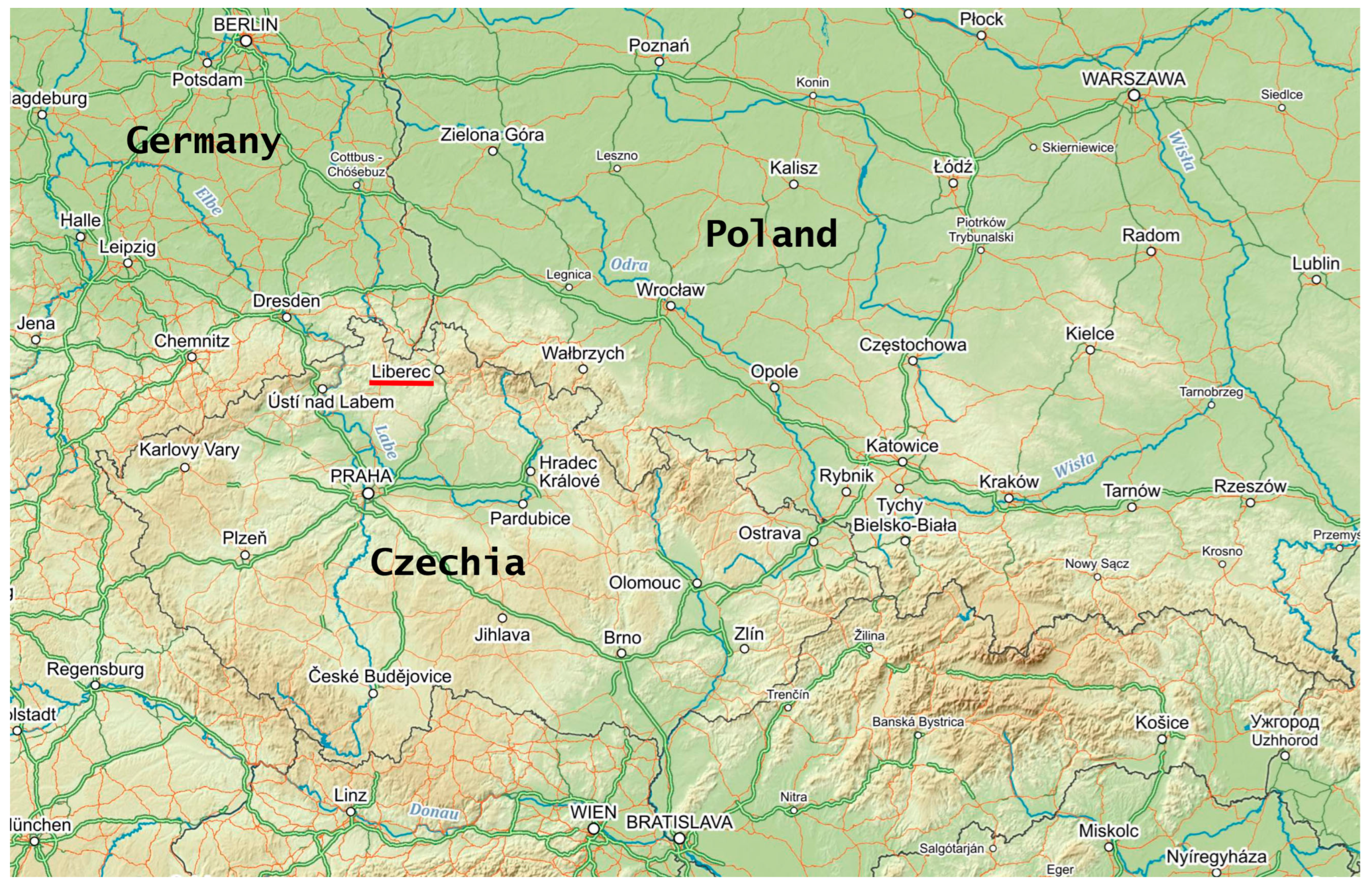
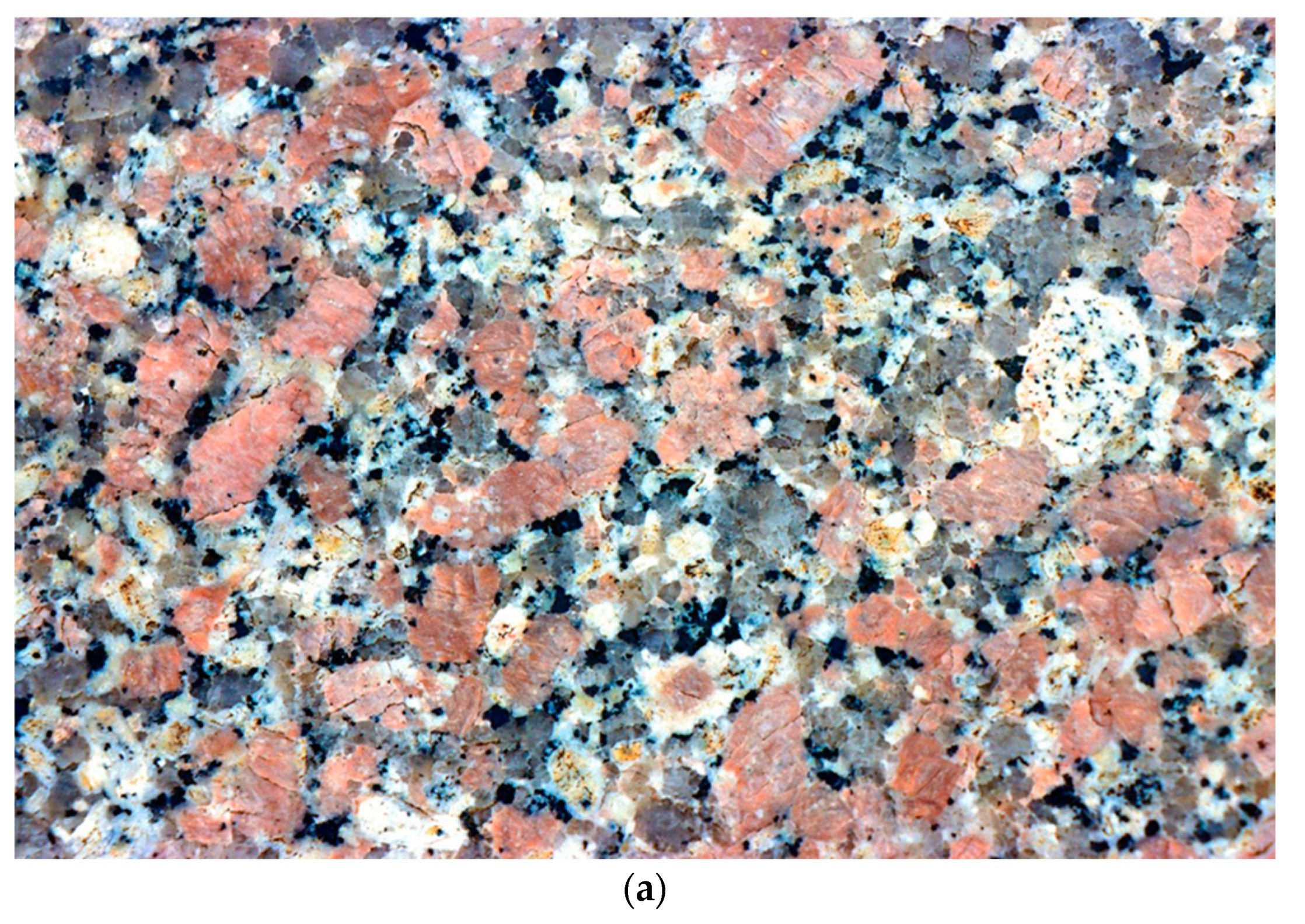

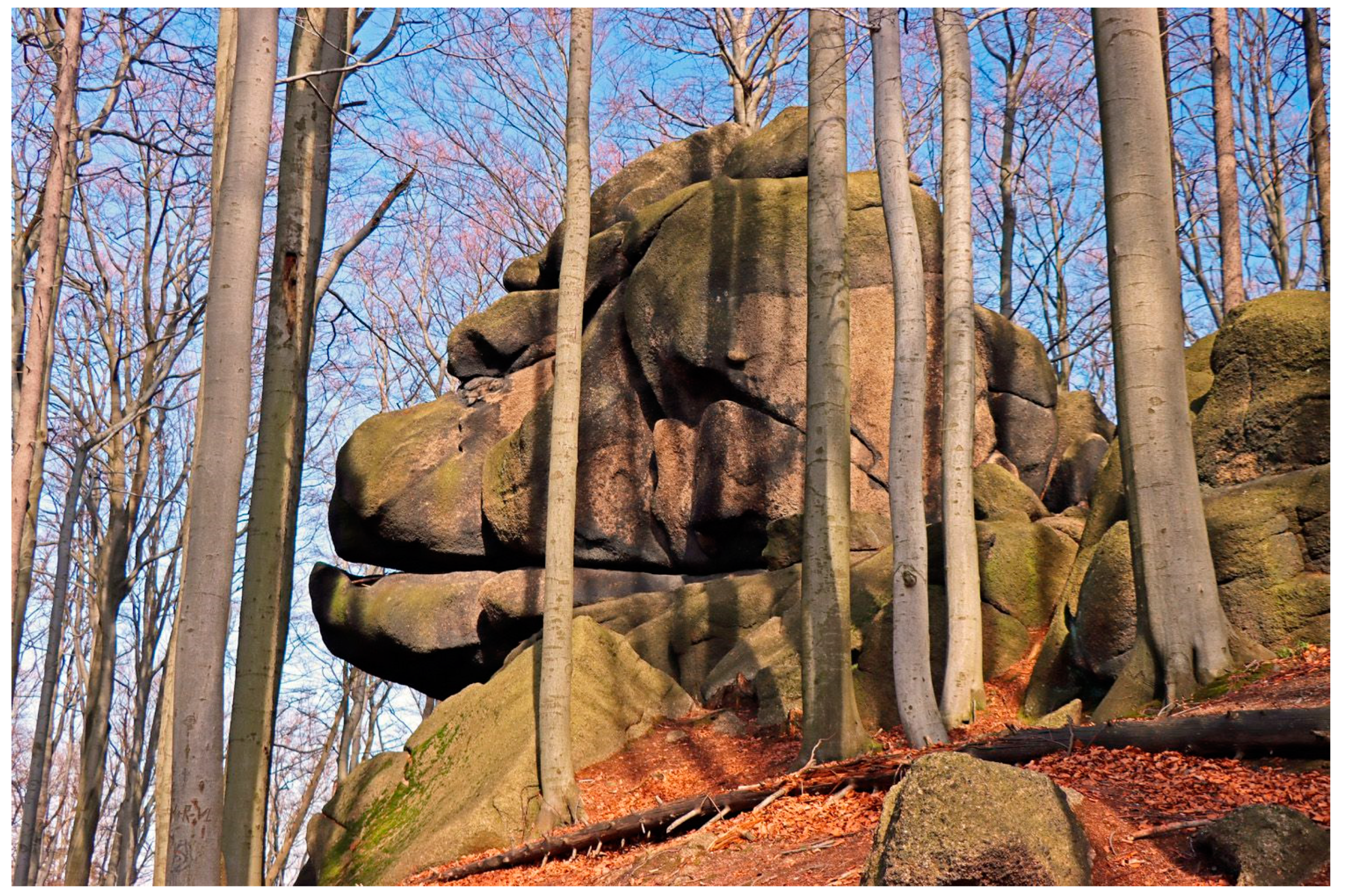
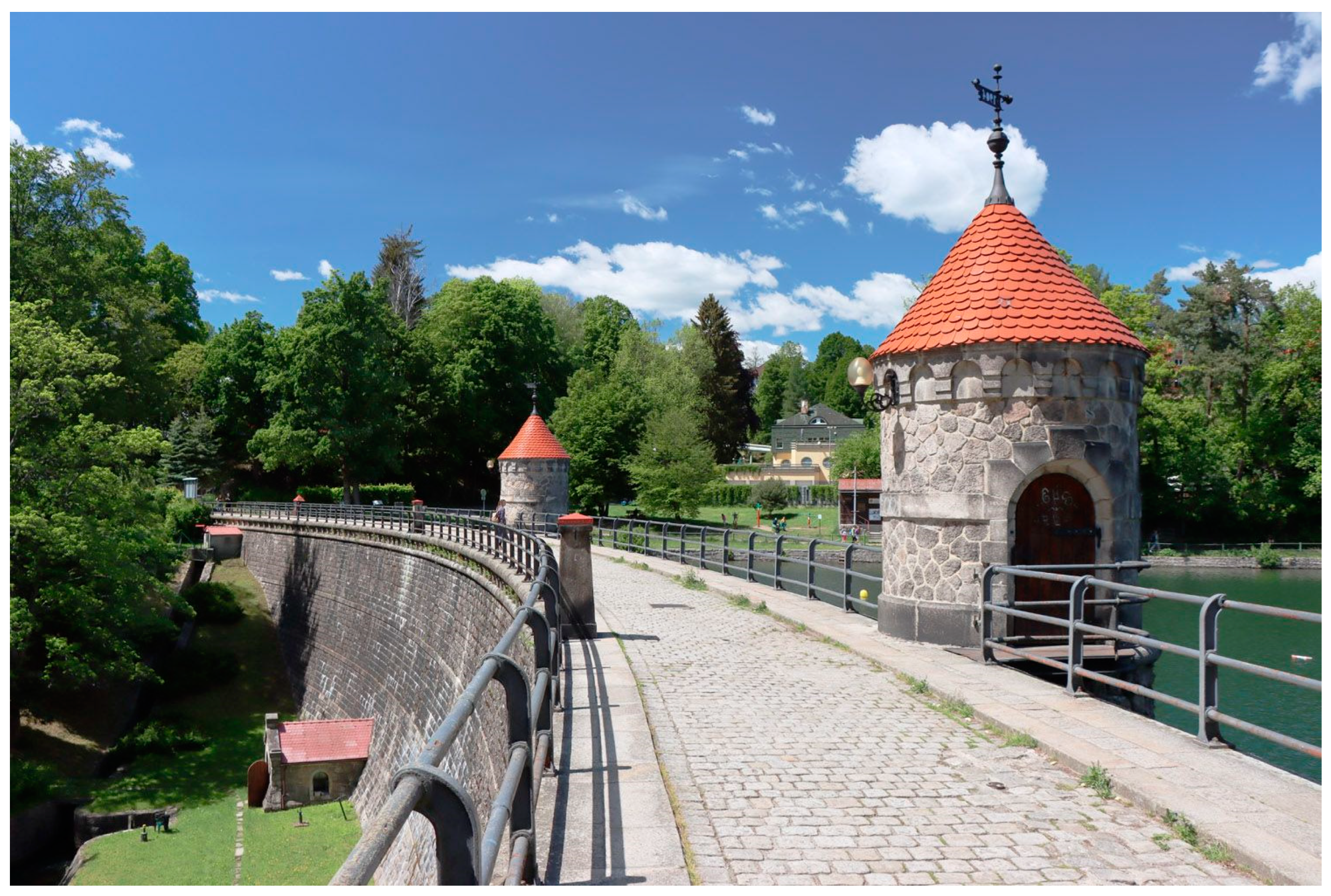
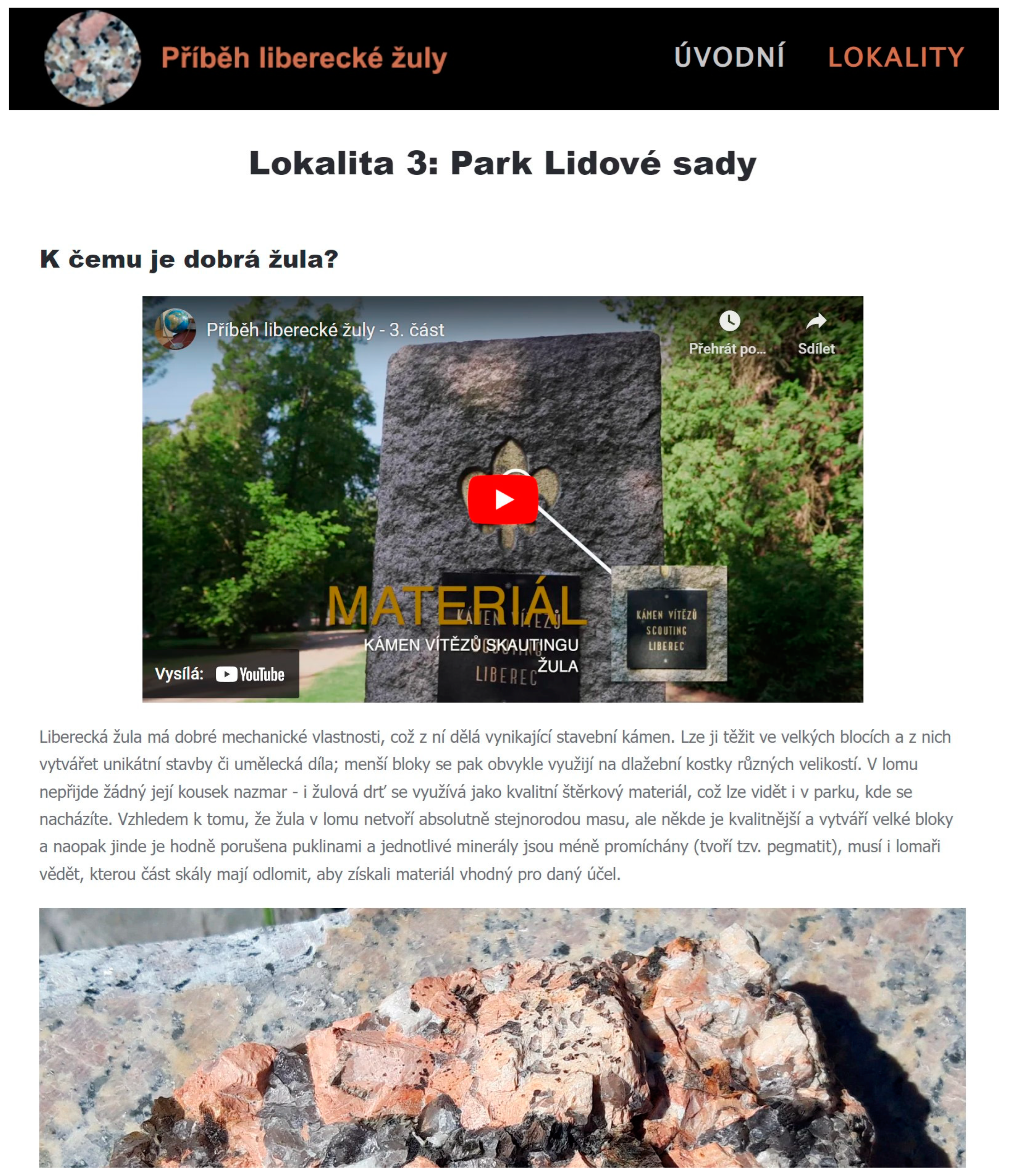

| Question | Answers Given by at Least 3 Respondents |
|---|---|
| Did you use didactic materials from the nature trail website in your fieldwork? In what way? | 90.2% yes (37 out of 41) |
| As a supplement to my explanation (33/41) | |
| As an activation method (29/41) | |
| As an ongoing task, which the students had to perform (7/41) | |
| As a means of teamwork (6/41) | |
| Have you used videos, texts and images from the nature trail website in your fieldwork? In what way? | 100% yes (41 out of 41) |
| As a supplement to my explanation (33/41) | |
| The students were divided into groups and had to report to the others on the part they had studied (15/41) | |
| As an ongoing task, which the students had to perform (6/41) | |
| To practice working with text (5/41) | |
| We used school tablets (5/41) | |
| We downloaded videos to school tablets (5/41) | |
| Did your field training include the whole route of the nature trail or only a part of it? Why did you choose this option? | 75.6% all the way (31 out of 41) |
| The whole route: | |
| It makes the most sense to walk the whole trail (30/41) | |
| It’s just long enough (12/41) | |
| We wanted to use the full potential of the trail (9/41) | |
| Only part of it: | |
| We have too young pupils, it would be too long for them (8/41) | |
| We didn’t have that much time (3/41) |
| Question | Answers Given by at Least 3 Respondents |
|---|---|
| What was the response of your pupils or students to the virtual nature trail “The Story of Liberec Granite”? What did they like and what did they like less? | Liked it: |
| Unusual theme (15/41) | |
| Surprising what all geology affects (13/41) | |
| Nice walk (8/41) | |
| Research tasks (7/41) | |
| Search in the field (5/41) | |
| Didn’t like it: | |
| Some pupils were not interested in the topic (9/41) | |
| Walking uphill (6/41) | |
| Some students were not able to find the phenomena mentioned in the field (4/41) | |
| What do you personally like or dislike about the virtual nature trail “The Story of Liberec Granite”? What could we improve? | Liked it: |
| Interesting topic (38/41) | |
| Nice walk (14/41) | |
| Well elaborated dramaturgy (12/41) | |
| Research tasks (11/41) | |
| It’s close, we don’t have to go far (5/41) | |
| What to improve: | |
| Graphic design of some outputs (maps, worksheets) (16/41) | |
| Give teachers methodological guidance (7/41) | |
| Is everything clear to you from the texts on the website, or have your pupils or students asked you a question you couldn’t answer? | 22.0% encountered a question they could not answer (9 out of 41) |
| Do you think that a similar virtual nature trail could work in the countryside, or is it more suited to the city? | 68.3% yes, it can work in nature (28 out of 41) |
| Pros: | |
| Today, there is good mobile signal coverage everywhere (8/41) | |
| In nature, the experience can be even more intense (7/41) | |
| Arguments against: | |
| There’s a bad cell signal (11/41) | |
| Couldn’t load videos (10/41) |
Disclaimer/Publisher’s Note: The statements, opinions and data contained in all publications are solely those of the individual author(s) and contributor(s) and not of MDPI and/or the editor(s). MDPI and/or the editor(s) disclaim responsibility for any injury to people or property resulting from any ideas, methods, instructions or products referred to in the content. |
© 2023 by the author. Licensee MDPI, Basel, Switzerland. This article is an open access article distributed under the terms and conditions of the Creative Commons Attribution (CC BY) license (https://creativecommons.org/licenses/by/4.0/).
Share and Cite
Drápela, E. Using a Geotrail for Teaching Geography: An Example of the Virtual Educational Trail “The Story of Liberec Granite”. Land 2023, 12, 828. https://doi.org/10.3390/land12040828
Drápela E. Using a Geotrail for Teaching Geography: An Example of the Virtual Educational Trail “The Story of Liberec Granite”. Land. 2023; 12(4):828. https://doi.org/10.3390/land12040828
Chicago/Turabian StyleDrápela, Emil. 2023. "Using a Geotrail for Teaching Geography: An Example of the Virtual Educational Trail “The Story of Liberec Granite”" Land 12, no. 4: 828. https://doi.org/10.3390/land12040828
APA StyleDrápela, E. (2023). Using a Geotrail for Teaching Geography: An Example of the Virtual Educational Trail “The Story of Liberec Granite”. Land, 12(4), 828. https://doi.org/10.3390/land12040828






